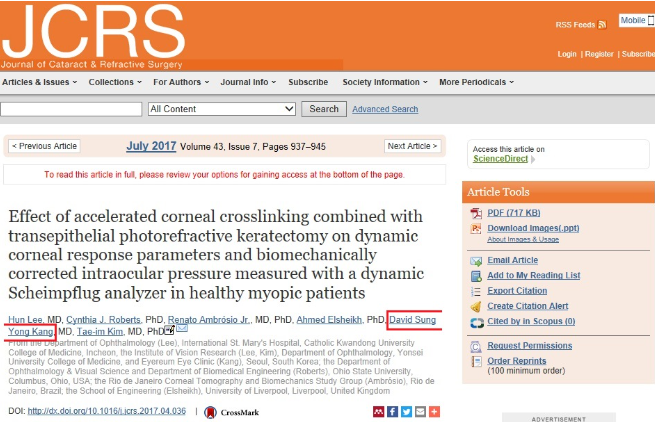
Effect of accelerated corneal crosslinking combined with transepithelial photorefractive keratectomy.(Dr. David Kang, EYEREUM EYE CLINIC)
EYEREUM's new paper had been published in Journal of Cataract & Refractive Surgery.
J Cataract Refract Surg. 2017 Jul;43(7):937-945. doi: 10.1016/j.jcrs.2017.04.036.
Effect of accelerated corneal crosslinking combined with transepithelial photorefractive keratectomy on dynamic corneal response parameters and biomechanically corrected intraocular pressure measured with a dynamic Scheimpflug analyzer in healthy myopic patients.

Abstract
PURPOSE:
To evaluate the effect of accelerated corneal crosslinking (CXL) combined with transepithelial photorefractive keratectomy (PRK) on changes in new dynamic corneal response parameters and the biomechanically corrected intraocular pressure (IOP) measured using a dynamic Scheimpflug analyzer (Corvis ST).
SETTING:
Yonsei University College of Medicine and Eyereum Eye Clinic, Seoul, South Korea.
DESIGN:
Retrospective case series.
METHODS:
Medical records of eyes of healthy myopic patients having transepithelial PRK or transepithelial PRK with CXL were examined. Main outcome variables were the biomechanically corrected IOP and new dynamic corneal response parameters including the deformation amplitude ratio at 1.0 mm (DAR1) and at 2.0 mm (DAR2), stiffness at first applanation and at highest concavity, and the integrated inverse radius preoperatively and 6 months postoperatively.
RESULTS:
The study comprised 69 eyes (69 patients); 35 had transepithelial PRK and 34, transepithelial PRK with CXL. The DAR1, DAR2, and integrated inverse radius significantly increased, while stiffness at first applanation and at highest concavity decreased postoperatively in both groups. Changes in the DAR2 and integrated inverse radius in the transepithelial PRK group were significantly larger than in the transepithelial PRK with CXL group without and with analysis of covariance with the spherical equivalent change or corneal thickness change as a covariate. No significant differences in the biomechanically corrected IOP occurred preoperatively or postoperatively in either group.
CONCLUSIONS:
Results indicate that prophylactic CXL combined with transepithelial PRK has a role in reducing the change in corneal biomechanical properties. The dynamic Scheimpflug analyzer showed stable biomechanically corrected IOP measurements preoperatively and postoperatively.
